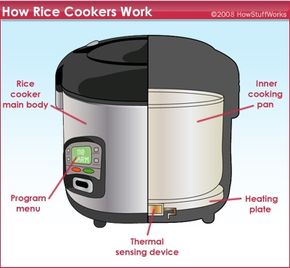Rice Cooker Basics
Rice needs two things to evolve from a hard, little grain to big, fluffy morsels -- lots of water and lots of heat. For this reason, cooking rice happens in four phases:
- Sitting in water
- Boiling
- Absorbing water (steaming)
- Resting
Rice cookers automatically guide rice through these four stages. The appliance consists primarily of a main body, an inner cooking pan, an electric heating plate, a thermal-sensing device and some buttons.
Advertisement
Water and rice sit inside the cooking pan while it's inserted into the rice cooker's shell. The pan's weight depresses the thermal-sensing device, and the heating plate quickly brings the water to a boil. The sensing device is a small, spring-loaded thermometer that gauges the temperature of the pan's contents. It's set into the bottom of the rice cooker's main body.
Simple rice cookers usually warm their contents by transferring heat from the heating plate to the cooking pan, and the type of metal used can improve that transfer. Some metals -- copper and aluminum for example -- are highly conductive. In other words, they transfer their heat easily. A wide range of materials can be used for the cooking pan, and each type may affect the overall time it takes to cook the food.
The process for cooking the rice is simple. Water boils at 212 degrees Fahrenheit (100 degrees Celsius), and once it reaches a steady boil, it won't get hotter. As long as there is water in the pan, the temperature should be stable. Once the rice absorbs all the water in the pan, the temperature will start to rise. The rice cooker senses this change and will either switch off or switch to a warming cycle. At this point, the rice has finished cooking and entered the resting stage.
While most rice cookers do not speed up the cooking process noticeably, they can accomplish the task with less mistakes and less fuss than the average person armed with a stovetop pot, especially when the cookers are equipped with fuzzy logic. Fuzzy logic lets a rice cooker react to what's happening in the pan, and we'll explore how it does this on the next page.
